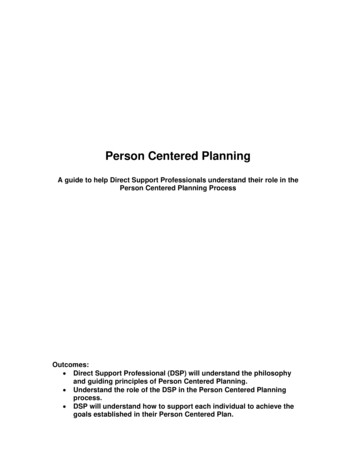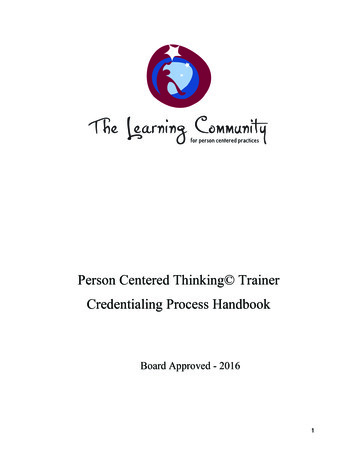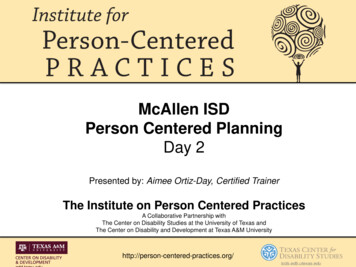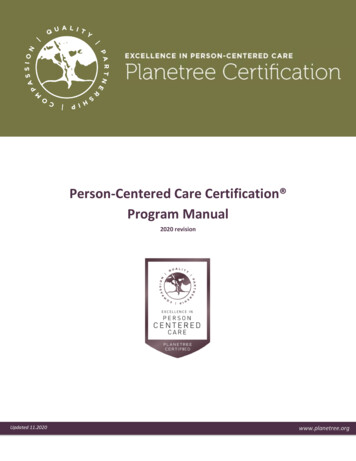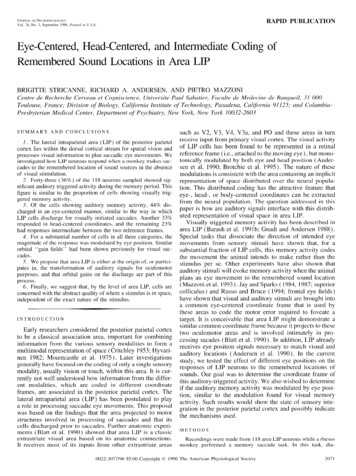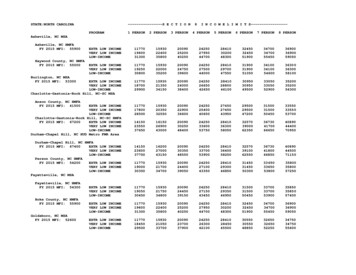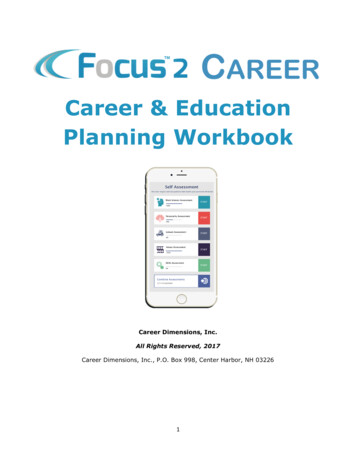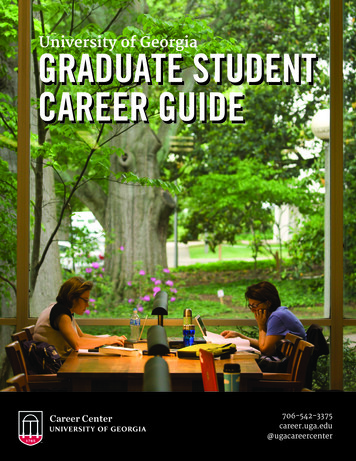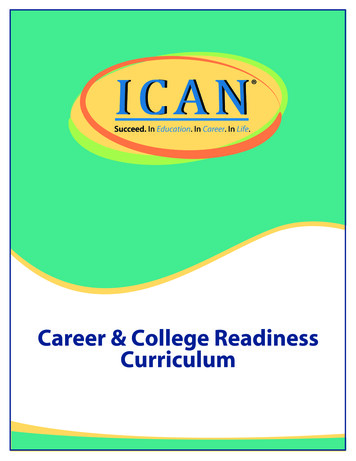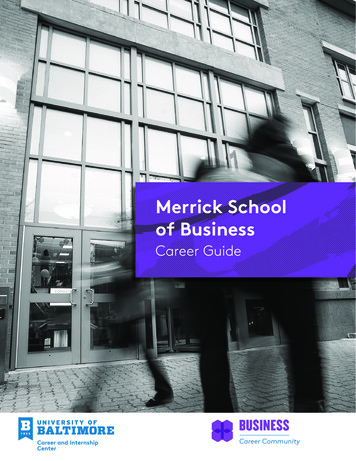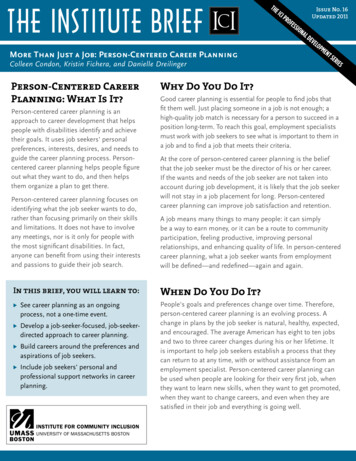
Transcription
The Institute BriefMore Than Just a Job: Person-Centered Career PlanningColleen Condon, Kristin Fichera, and Danielle DreilingerPerson-Centered CareerPlanning: What Is It?Person-centered career planning is anapproach to career development that helpspeople with disabilities identify and achievetheir goals. It uses job seekers' personalpreferences, interests, desires, and needs toguide the career planning process. Personcentered career planning helps people figureout what they want to do, and then helpsthem organize a plan to get there.Person-centered career planning focuses onidentifying what the job seeker wants to do,rather than focusing primarily on their skillsand limitations. It does not have to involveany meetings, nor is it only for people withthe most significant disabilities. In fact,anyone can benefit from using their interestsand passions to guide their job search.THEICIPROFESSIIssue No. 16Updated 2011ONALDEVELOPMENTSERIESWhy Do You Do It?Good career planning is essential for people to find jobs thatfit them well. Just placing someone in a job is not enough; ahigh-quality job match is necessary for a person to succeed in aposition long-term. To reach this goal, employment specialistsmust work with job seekers to see what is important to them ina job and to find a job that meets their criteria.At the core of person-centered career planning is the beliefthat the job seeker must be the director of his or her career.If the wants and needs of the job seeker are not taken intoaccount during job development, it is likely that the job seekerwill not stay in a job placement for long. Person-centeredcareer planning can improve job satisfaction and retention.A job means many things to many people: it can simplybe a way to earn money, or it can be a route to communityparticipation, feeling productive, improving personalrelationships, and enhancing quality of life. In person-centeredcareer planning, what a job seeker wants from employmentwill be defined—and redefined—again and again.In this brief, you will learn to:When Do You Do It?xx See career planning as an ongoingprocess, not a one-time event.People's goals and preferences change over time. Therefore,person-centered career planning is an evolving process. Achange in plans by the job seeker is natural, healthy, expected,and encouraged. The average American has eight to ten jobsand two to three career changes during his or her lifetime. Itis important to help job seekers establish a process that theycan return to at any time, with or without assistance from anemployment specialist. Person-centered career planning canbe used when people are looking for their very first job, whenthey want to learn new skills, when they want to get promoted,when they want to change careers, and even when they aresatisfied in their job and everything is going well.xx Develop a job-seeker-focused, job-seekerdirected approach to career planning.xx Build careers around the preferences andaspirations of job seekers.xx Include job seekers' personal andprofessional support networks in careerplanning.Institute for Community InclusionUniversity of massachusetts boston
Sara—The Power of a DreamWho Is Involved?Sara was a thirty-five-year-old woman with a significantdevelopmental disability who had been working in asheltered workshop for over ten years. One day she toldJoe, her employment specialist, that she wanted to workoutside of the workshop doing something new. When Joeasked Sara what she wanted to do, she could not comeup with any ideas. Joe asked her about her interests. Sarastated that she liked to do needlepoint, spend time withher nieces and nephews, and go shopping. When askedabout her dreams, Sara exclaimed, "I want to becomethe mayor of Boston, and I want to rebuild the city underwater!"Person-centered career planning may involve manypeople or just a few. However, the involvement ofa network of trusted people—a career-planninggroup—is usually a key component of the process.The job seeker works with the employmentspecialist to identify whom to involve, and the jobseeker has the final say in deciding who participatesand how.Were these realistic dreams? Hardly. But Joe didn't shut herdown. Instead, he followed up with more questions. Whatappealed to her about rebuilding the city underwater? Whydid she want to be the mayor? What would it feel like if herdream job were reality?After talking together, and including Sara's mother inthe discussion, Joe and Sara realized that her unrealistic"dream job" had some very practical applications. Saraloved politics (which generated the "mayor" idea), andshe was unhappy with her weight (being in the water feltcomfortable to her). Joe realized that Sara's tight work areaat the workshop made her uncomfortable, both physicallyand emotionally.Joe and Sara used these interests and her desire to changeto pursue a course of action. Sara found a new job in a largecollege library, joined the volunteer squad for a politicalcampaign, and started to meet regularly with a nutritionistto lose weight.Lessons learned: Even an "impossible" dream holds important clues toa person's interests and needs. Make sure to ask about a job seeker's interests. It'simportant to know what drives the person. Ask questions to find out the "whys" behind jobseekers' answers. People are more open to working with you when youdon't ignore their desires and passions.2 Institute for Community InclusionWhen choosing whom to involve in the careerplanning group, ask:xx How well do they know the job seeker?xx Can they contribute to planning?xx Are they willing to participate?xx Will they follow through on commitments?Some job seekers will want to work one-on-one withtheir employment specialist. Others will want tocall a few people to solicit their opinions, and stillothers will want a big meeting with everyone theyknow. Family members, friends, professionals, andemployers might be involved, but it will be differentfor everyone.There are four key componentswhen developing a Person-CenteredCareer Plan:1.Organizing resources2. Figuring out what makes a "good" job3. Choosing a job4. Establishing a lifelong process ofplanning and development
Organizing resourcesThis is when the job seeker andemployment specialist decide who will beinvolved in the process and what the process willlook like. Again, this will be different for everyone.For some, it will begin with a large gathering,with numerous family members, friends, andprofessionals in attendance. For others, it will be aseries of one-on-one meetings with an employmentspecialist, or phone calls to key individuals in the jobseeker's life.Figuring out what makes a"good" jobThe next task should be to develop aprofile of the job seeker. This includes informationabout activities, likes, and dislikes at home, work,school, and recreation. The employment specialistwill need to consider what choices the job seekerhas made, what influenced those choices, and whyhe or she liked or disliked certain activities. Thesequestions often require some probing before they areanswered.Don't be concerned if the conversation includescomponents that seem unrealistic (see sidebar:"Sara: The Power of a Dream"). Talking with peopleabout their hopes and desires can help you learnmore about them and help them to think aboutthings they enjoy, which may lead to a job, or perhapspart of a job.The next step is to look at recurringthemes from the job seeker'sprofile and try to tie them togetherinto a coherent job description.Many times job seekers' interests,likes, and dislikes are ignoredin favor of skills, aptitudes, andlearning assessments. Employmentspecialists need to attend to thehopes and passions of job seekersas well. At this point, begin tobrainstorm possible jobs, tasks,and locations, and to list contactsof people in the career-planning group. These shouldall be chosen to fit the job seeker's skills and interests.Finally, it is important to look at possible barriers tosucceeding in the jobs that were listed. The point ofthis is not to eliminate jobs from consideration butto "get a leg up" on solving problems before they canget in the way of a successful placement.Choosing a jobOnce job development efforts haveresulted in a possible job match, thejob seeker and employment specialist use theinformation they've gathered to decide whether thatjob meets the goals outlined. You can also use thisanalysis phase to examine whether a current job stillmeets a job seeker's needs.People often make compromises in life choices,and job choices are no different. It is often difficultto gather all of the information about a job beforedeciding to make a commitment. Job matching isan art, not a science, and many decisions have tobe made by "feel" and by relying on intuition. Thereis no magic formula that will distinguish betweenmaking a sensible compromise and settling foran unacceptable job offer. It takes a good workingrelationship with the job seeker and potentialemployer. The service provider must also be able togive advice while respecting the job seeker's ultimateresponsibility to make their own life choices.Is it a good job match?What was the initial stated career goal (including job title, salary, hours, and benefits)? Does this job fit with it? If not, are these compromises the job seeker is willing to make?What is the culture like at the potential place of employment? Is this a culture that the job seeker wants and will fit in with?Does the job seeker currently have the ability to do the job? If not, what training is needed to help the job seeker get the skills? How will the job seeker get this training?
Establishing a lifelongprocess of planning anddevelopmentIf we are committed to career planning as anongoing process, evaluation is not an endingbut the beginning of a new phase. Employmentspecialists need to encourage and enable jobseekers to reevaluate their current employmentsituation and move on to other job options whendesired. Traditionally, workers have had to developjob-related problems or lose their jobs beforefurther career planning would be offered. Ongoingevaluation is meant to legitimize job change ashealthy, natural, and expected, rather than atypicalor problematic. The evaluation process, done atregular intervals or in response to worker or familyrequests, answers the following questions:xx Have things changed for the worker, for his/hersignificant others, or in the job?xx Is the worker dissatisfied, bored, or havingconcerns with his/her job?xx Is the employer dissatisfied or having concernswith the worker's performance?If the answer to all three is "no," then for the timebeing no job change is needed. However, evenwhen all parties are satisfied with the current stateof affairs, regular reviews should still take place.This will keep the career-planning group on top ofany changes that occur.If the answer to any of the above questions is"yes," the reasons need to be analyzed. People'slikes, dislikes, and aspirations change over time.If the worker and other interested people decide ajob change is needed, then it's time to repeat thecareer-planning process. The job seeker's profileshould be reviewed with the career-planning group,and the group should support the job seekerin making modifications to a current job or infinding a new one. The composition of the careerplanning group will probably change over time asthe job seeker's network expands and as members'professional and personal lives evolve.Justin —Exceeding ExpectationsJustin had been out of high school for two years and was working at afast-food restaurant. Everyone saw this as a great success, except forJustin. What he really wanted to do was work in an office like the restof his family, but due to his Attention-Deficit/Hyperactivity Disorder hewas told that this goal was not realistic. After begging for a chance tolearn how to use computers, Justin enrolled in a program to learn basicword-processing skills. He completed six months of training, but scoredvery low on all the word-processing tests. A team meeting was held todetermine Justin's next step.Attending the meeting were Justin, his father, his sister Theresa, hisemployment specialist Jodi, his VR counselor Bob, and his traininginstructor Lisa. The meeting began on a very negative note, with Lisa andBob describing what a failure the computer training program had beenfor Justin. Everyone at the meeting, except for Justin and Jodi, agreedthat an office job would not be realistic for him and thought that heshould concentrate on working at the restaurant.Justin was upset by their reaction. He and Jodi had met the day before totalk about his desire to work in an office and the skills he would bring toan office position. He talked about wanting to get dressed up every day,to commute into the city, and to work in a corporate environment.After a long meeting, a compromise was made: Justin would continueworking at the restaurant four days a week, and would spend one daylooking for a job. He asked everyone for assistance with his job search.Four months later, Justin's persistence paid off: He was offered a full-timejob working in a mailroom at the same company as his sister. Theresa hadarranged for an informational interview and tour of the mailroom forJustin, which led to the job. Even though there was a gap between theexact skills needed for the job and Justin's current abilities, Jodi helpedhim recognize all the skills he had learned working at the restaurant: timemanagement, customer service, working in a fast-paced environment, andhandling multiple tasks. After initial job coaching from Jodi, Justin becameindependent on the job with some natural supports from his co-workers.Five years later, Justin has been promoted twice within his company. Henow works the front desk in the main reception area greeting guests,logging in packages, and doing some basic data entry on his own computer.Lessons learned: Believe in people and their abilities. Work with job seekers' enthusiasms. Help people recognize the transferable skills they have.Issue No. 16, Institute Brief 4
Resources —Where To Go From HereCareer Development and Job Search Booksxx Demystifying Job Development: Field-Based Approaches to Job Developmentfor People with Disabilities.David Hoff, Cecilia Gandolfo, Marty Gold, & Melanie Jordan. TRN, Inc., 2000.xx The Career Guide for Creative and Unconventional People.Carol Eikleberry, Ph.D. Ten Speed Press, 1995.xx What Color Is Your Parachute? A Practical Manual for Job-Hunters & Career-Changers.Richard N. Bolles. Ten Speed Press, updated annually.xx Job Search Handbook for People with Disabilities.Dr. Daniel J. Ryan. Jist Publishing, 2004.Assessment and Career Exploration ToolsAmerica's Labor Market Information System and America's Career Kit have a number ofexcellent resources:xx America's Career InfoNet (www.acinet.org) includes a wealth of information on job trends,wages, and national and local labor markets. Click on "Career Tools" to get started.xx O*NET Online (http://online.onetcenter.org) is a database that describes a wide variety ofoccupations and their requisite skills and earning potential.xx O*NET Career Assessment and Exploration Tools (www.onetcenter.org/product/tools.html)has several self-assessments.ICI Publications (available at www.communityinclusion.org)xx Getting the Most from the Public Vocational Rehabilitation System.Tools for Inclusion, Issue No. 19.xx Making Networking Easier for Job Seekers: A Guide.Institute Brief, Issue No. 20.xx Starting with Me: A Guide to Person-Centered Planning for Job Seekers.Tools for Inclusion, Issue No. 14.xx Networking: Your Guide to an Effective Job Search.Tools for Inclusion, Issue No. 7.www.community5Issue No. 16, Institute Brief
training and consultationon person-centeredplanningThe ICI offers training and consultation onperson-centered planning and other jobdevelopment activities for employment staffand job seekers. Contact Cecilia Gandolfofor information about how we can help youimprove your outcomes.Cecilia Gandolfo(617) 287-4342 (voice)(617) 287-4350 (TTY)cecilia.gandolfo@umb.eduThis issue of The Institute Brief is apublication of the New England TACECenter (Region 1), a project of theInstitute for Community Inclusion at theUniversity of Massachusetts Boston.The New England TACE Center is fundedby the U.S. Department of Education,Rehabilitation Services Administration(grant #H235M010131).AcknowledgementsThe authors would like to acknowledgePhil Zukas, Laurie Anderson, and SeanCondon for their contributions to thisbrief, as well as Melanie Jordan, DavidHoff, John Butterworth, Cecilia Gandolfo,and Anya Weber.For more lusion.Melanie JordanInstitute for Community InclusionUniversity of Massachusetts Boston100 Morrissey Blvd.Boston, Massachusetts 02125(617) 287-4327 (voice)(617) 287-4350 (TTY)melanie.jordan@umb.eduThis publication will be madeavailable in alternate formatsupon request.
guide the career planning process. Person-centered career planning helps people figure out what they want to do, and then helps them organize a plan to get there. Person-centered career planning focuses on identifying what the job seeker wants to do, rather than focusing primarily on their skills and limitations. It does not have to involve any .
